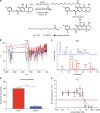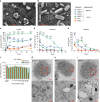Creation of a long-acting nanoformulated dolutegravir
- PMID: 29402886
- PMCID: PMC5799307
- DOI: 10.1038/s41467-018-02885-x
Creation of a long-acting nanoformulated dolutegravir
Abstract
Potent antiretroviral activities and a barrier to viral resistance characterize the human immunodeficiency virus type one (HIV-1) integrase strand transfer inhibitor dolutegravir (DTG). Herein, a long-acting parenteral DTG was created through chemical modification to improve treatment outcomes. A hydrophobic and lipophilic modified DTG prodrug is encapsulated into poloxamer nanoformulations (NMDTG) and characterized by size, shape, polydispersity, and stability. Retained intracytoplasmic NMDTG particles release drug from macrophages and attenuate viral replication and spread of virus to CD4+ T cells. Pharmacokinetic tests in Balb/cJ mice show blood DTG levels at, or above, its inhibitory concentration90 of 64 ng/mL for 56 days, and tissue DTG levels for 28 days. NMDTG protects humanized mice from parenteral challenge of the HIV-1ADA strain for two weeks. These results are a first step towards producing a long-acting DTG for human use by affecting drug apparent half-life, cell and tissue drug penetration, and antiretroviral potency.
Conflict of interest statement
The authors declare no competing financial interests.
Figures






Similar articles
-
Pharmacokinetics of a Long-Acting Nanoformulated Dolutegravir Prodrug in Rhesus Macaques.Antimicrob Agents Chemother. 2017 Dec 21;62(1):e01316-17. doi: 10.1128/AAC.01316-17. Print 2018 Jan. Antimicrob Agents Chemother. 2017. PMID: 29061742 Free PMC article.
-
Multimodal Theranostic Nanoformulations Permit Magnetic Resonance Bioimaging of Antiretroviral Drug Particle Tissue-Cell Biodistribution.Theranostics. 2018 Jan 1;8(1):256-276. doi: 10.7150/thno.22764. eCollection 2018. Theranostics. 2018. PMID: 29290806 Free PMC article.
-
The Combination of the R263K and T66I Resistance Substitutions in HIV-1 Integrase Is Incompatible with High-Level Viral Replication and the Development of High-Level Drug Resistance.J Virol. 2015 Nov;89(22):11269-74. doi: 10.1128/JVI.01881-15. Epub 2015 Aug 26. J Virol. 2015. PMID: 26311878 Free PMC article.
-
Comparative Clinical Pharmacokinetics and Pharmacodynamics of HIV-1 Integrase Strand Transfer Inhibitors.Clin Pharmacokinet. 2017 Jan;56(1):25-40. doi: 10.1007/s40262-016-0424-1. Clin Pharmacokinet. 2017. PMID: 27317415 Free PMC article. Review.
-
The Promise of Dolutegravir: A Novel Second Generation Integrase Strand Transfer Inhibitor.Curr Clin Pharmacol. 2016;11(2):88-94. doi: 10.2174/1574884711666160329192333. Curr Clin Pharmacol. 2016. PMID: 27157040 Review.
Cited by
-
A long acting nanoformulated lamivudine ProTide.Biomaterials. 2019 Dec;223:119476. doi: 10.1016/j.biomaterials.2019.119476. Epub 2019 Sep 5. Biomaterials. 2019. PMID: 31525692 Free PMC article.
-
Immune Activations and Viral Tissue Compartmentalization During Progressive HIV-1 Infection of Humanized Mice.Front Immunol. 2019 Feb 28;10:340. doi: 10.3389/fimmu.2019.00340. eCollection 2019. Front Immunol. 2019. PMID: 30873181 Free PMC article.
-
Rod-shape theranostic nanoparticles facilitate antiretroviral drug biodistribution and activity in human immunodeficiency virus susceptible cells and tissues.Theranostics. 2020 Jan 1;10(2):630-656. doi: 10.7150/thno.39847. eCollection 2020. Theranostics. 2020. PMID: 31903142 Free PMC article.
-
Nanotechnology approaches for delivery of cytochrome P450 substrates in HIV treatment.Expert Opin Drug Deliv. 2019 Aug;16(8):869-882. doi: 10.1080/17425247.2019.1646725. Epub 2019 Jul 24. Expert Opin Drug Deliv. 2019. PMID: 31328582 Free PMC article. Review.
-
Pharmacokinetic testing of a first-generation cabotegravir prodrug in rhesus macaques.AIDS. 2019 Mar 1;33(3):585-588. doi: 10.1097/QAD.0000000000002032. AIDS. 2019. PMID: 30289818 Free PMC article.
References
Publication types
MeSH terms
Substances
Grants and funding
LinkOut - more resources
Full Text Sources
Other Literature Sources
Research Materials

